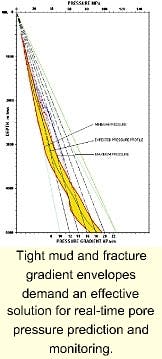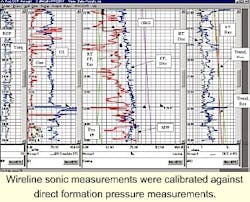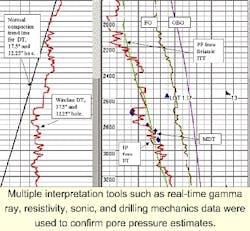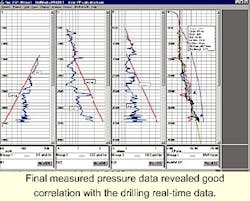Pore pressure prediction allows for tighter pressure gradient control
Real time pore pressure prediction soft ware was introduced for the first time in Shell's Norwegian drilling operations in 1996. This trial was followed by the intro duction of the program to drilling opera tions in the South China Sea, as a tool to optimize the mud gradient and casing setting depths on high pressure, high temperature (HPHT) exploration wells. Since introduction into the area, the program has been used on several HPHT exploration wells on land, offshore, and on a recent deepwater exploration campaign.
This article describes the successful application on the deepwater exploration well "Well-1", where DrillWorks/Predict, a software product from Knowledge Systems, predicted pore pressures in excess of what was originally anticipated in the well drilling program. This prevented the occurrence of at least one kick and accurately established the maximum safe drilling depth for the well design and pressure rating of the rig's blow out preventer (BOP) equipment.
Pressure indicators
DrillWorks/Predict was first introduced in the company's drilling operations on a deep onshore HPHT well. The software was successfully interfaced with real-time logging while drilling (LWD) data, but failed to predict the formation pressures encountered, as the geological setting was dominated by inflationary effects. The standard methods used in the software provide estimates of overpressures developed by under-compaction.
It was recognized that the ongoing offshore HPHT exploration campaign could benefit from real-time pore pressure data, as these wells were commonly drilled with a very narrow operating envelope between the mud and fracture gradients. Better knowledge of the actual pore pressure would allow rationalization of mud gradients, optimization of casing setting depths, and early identification of potential formation fluid influxes.
Past experience indicated that the calculations required input of good quality offset data, direct pressure measurements, and trends in gas shows and/or kicks. To properly calibrate the system and obtain valid results, wireline, LWD, drilling data, and other related information are input and interpreted in either real time or as available.
It became apparent that real-time pressure monitoring could not be achieved optimally with a stand-alone set-up and preference was given to running the system with a dedicated engineer from Geopressure Systems, a division of Knowledge Systems.
Confirming prediction
The most recent application of the pore pressure prediction software was the exploration well, "Well-1", drilled from a drillship in a water depth in excess of 450 meters in the South China Sea. The initial pressure prognosis of the objectives was based on seismic velocities, calibrated to the only available offset well, some 9.5 km away. This prognosis indicated progressive development of pore pressures of up to 0.80 psi/ft with an uncertainty of +/- 0.1 psi/ft below the 9 5/8-in. casing shoe.
The rig's BOP equipment was rated to 10,000 psi, with the casing design matching this pressure rating. It was imperative that total depth of the well should not exceed the depth at which the pore pressures exceeded the design criteria for the casing and BOP equipment. In view of these tight pressure tolerances, it was decided to use the DrillWorks/Predict tool to predict and monitor real-time pore pressures during drilling.
The service was used from the 20-in. casing shoe set at 1,xxx m to the final TD of the well. Wireline data from the top hole sections was used as a starting point for the calculations, and real time gamma ray and resistivity data, provided by the LWD, used to update the predictions while drilling the 17 1/2-in. and 12 1/4-in. hole sections. In the absence of direct pressure measurements, it was not possible to verify the calibration of the calculations. The occurrence of two kicks in the 12 1/4-in. hole section indicated that the actual pore pressures exceeded the real-time pore pressure predictions and were also significantly higher than the prognoses. The section was drilled to a depth of 3,xxx meters with a final mud gradient of 0.66 psi/ft and a full suite of wireline logs was obtained, including measured formation pressures. This enabled full calibration of the calculations and a good data set, in agreement with the measured formation data.
The 9 5/8-in. casing was set at 3,xxx meters and a shoe strength of 0.84 psi/ft was established by the leak-off test. The calibrated data sets in DrillWorks/Predict were used for monitoring pore pressures while drilling the 8 1/2-in. hole. Pressure predictions were updated with input from real-time gamma ray and resistivity data from the LWD (with the sensors 3.5 meters and 5.8 meters, respectively, behind the bit). Drilling data such as corrected drilling exponent, rotary torque, formation gas, and other parameters were also input as available. The software predictions indicated trends of progressively increasing pore pressures in the shale sections drilled. This was confirmed by a kick taken after penetrating a thin isolated sand layer at 3,xxx meters. The influx was circulated out with a mud gradient of 0.78 psi/ft. The pressures encountered were in excellent agreement with the predicted data. This event contributed to a high level of confidence in the data and interpretation of the trends in real time.
Pressure predictions
Drilling continued and the pore pressure predictions were closely monitored throughout the remaining critical section of the well. The predictions clearly indicated that the pore pressures were continuing to increase, and at 3,xxx meters it was decided to increase the mud gradient to 0.8 psi/ft before entering one of the well objectives. The effective circulating density (ECD) began approaching the leak-off pressure equivalent mud weight, requiring the remainder of the well to be drilled with reduced circulating parameters within a very narrow and rapidly closing operating window between the formation and leak-off pressures.
The pore pressure predictions indicated that the objective sands could be penetrated safely and within the limitations of the well design. In addition to this, it provided the well engineers and their customer departments with the most accurate information available at the time of drilling, and to justify the decision to perform intermediate wireline logging.
A logging pocket was drilled to a depth of 3,xxx meters and a minimum suite of wireline logs was obtained, including direct measurements. Later analysis showed the real-time predicted pore pressures to be in excellent agreement with the measured formation pressures.
Extrapolations beyond the current depth of the well (based on available seismic velocities) demonstrated that the safe operating envelope was shrinking. Based on this information, it was decided to call total depth early, and obtain the final suite of wireline logs, leaving some of the deeper secondary objectives of the well un-drilled.
Time savings, safety
The application of DrillWorks/Predict on Well-1 increased confidence in the software and provided well engineers with a tool to fine-tune mud gradients and define safe drilling depths, by reducing the uncertainties of the expected pore pressure profile during the drilling process.
The application on Well-1 prevented the occur rence of at least one kick, resulting in an estimated time saving of 12-20 hours. Time savings and the ability to drill tight pressure gradient envelopes safely have given the operator added insurance on high profile HPHT well projects. The use of the program will therefore be continued on future exploration and HPHT wells.
Acknowledgement
The authors would like to thank Eamonn Doyle of Geopressure Systems for support in the field and contributions to this article.




